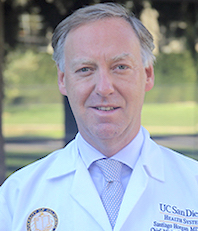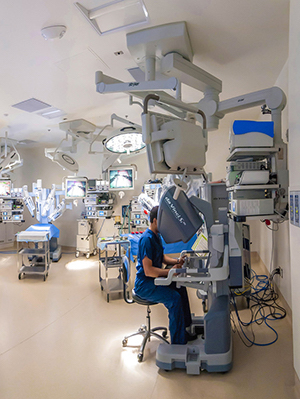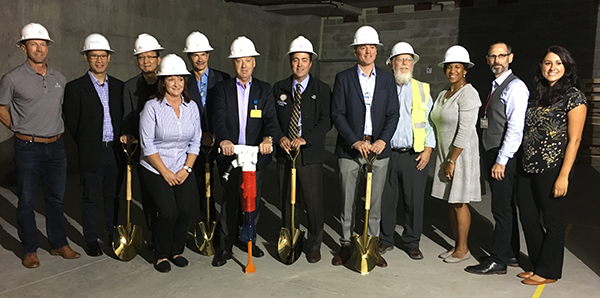Q & A with Santiago Horgan
 Santiago Horgan directs the Center for the Future of Surgery (CFS) and is Chief of the Division of Minimally Invasive Surgery. Before joining the Department of Surgery at UC San Diego School of Medicine in 2006, Dr. Horgan was director of the Minimally Invasive Surgery and Robotic Surgery Department and co-director of the Swallowing Center at the University of Illinois at Chicago. He was also director of the Minimally Invasive Bariatric Center in Chicago. In this interview he talks about what led him to surgery, the ongoing expansion of the CFS, and why it’s important to be business-savvy when you’re a surgeon.
Santiago Horgan directs the Center for the Future of Surgery (CFS) and is Chief of the Division of Minimally Invasive Surgery. Before joining the Department of Surgery at UC San Diego School of Medicine in 2006, Dr. Horgan was director of the Minimally Invasive Surgery and Robotic Surgery Department and co-director of the Swallowing Center at the University of Illinois at Chicago. He was also director of the Minimally Invasive Bariatric Center in Chicago. In this interview he talks about what led him to surgery, the ongoing expansion of the CFS, and why it’s important to be business-savvy when you’re a surgeon.
October 1, 2018 | Interview by Lindsay Morgan
You grew up in Argentina and completed your surgery residency at the University of Buenos Aires School of Medicine, where you also received your medical degree. Your father was a surgeon. At what point did you decide to follow in his footsteps?
I used to round with him, beginning when I was 4 years old. He would take me to the hospital; I would wait outside the room, and we would round all day. I was able to watch him operate when I was 14 or 15, and I loved it. If you asked my mother or my grandparents, they’d say: Santi always wanted to be a surgeon.
Did being exposed early to the realities of what being a surgeon is all about help to shed some of the romanticism about it as a career?
I knew the good and the bad. I knew that he was always on call. I saw him as a young surgeon and as a chief and as a director of a hospital—all the career phases. I knew the challenges to being successful, which are many. But I looked at my dad as an example of what I wanted to be. And my mom showed me how to be fearless in chasing a dream.
Was being exposed to surgery—and therefore to human frailty—at such a young age ever scary?
No. If I had doubts they were doubts about—am I going to be successful. That was the scary part of being a surgeon for me.
 You are the Director of the Center for the Future of Surgery, which opened in 2011 and provides unparalleled surgical training and simulation. You were instrumental in conceiving of and bringing the idea of a CFS to fruition, along with Mark Talamini, the former chair. Where did the idea for the CFS come from?
You are the Director of the Center for the Future of Surgery, which opened in 2011 and provides unparalleled surgical training and simulation. You were instrumental in conceiving of and bringing the idea of a CFS to fruition, along with Mark Talamini, the former chair. Where did the idea for the CFS come from?
In surgery today, technology is evolving, techniques are changing, new devices are coming out all the time. There are still many operations that are still done open because surgeons don’t have the skills.
There is also a paradigm shift in the degree to which patients tolerate being part of the learning curve in the operating room. That is gone. Surgeons need a place to practice outside of the operating room.
The idea of a CFS was natural to me. I have been exposed to outside-the-box training since Argentina where we had a training lab. When when I came to Seattle as a third-year resident I witnessed the construction of the training center and the early take off of laparoscopic surgery, and the challenges it posed for education.
When I moved to Chicago, I was in charge of building the training center there, and then when I was recruited here by Mark Talamini I came with a plan with Mark to build a training center. We wanted to be a premier place in the world where people can come to train. We dreamed big, and we got the support of Maria Savoia, the Dean for Medical Education, and Dave Brenner, the Vice Chancellor of Health Sciences. It was a coming together of an amazing idea and strong institutional support. And it happened.
And today we are one of the leading training centers in the world. Just last month, we hosted the SAGES Flexible Endoscopy Course, which brought together trainees, fellows and the president of SAGES, Jeffrey Marks, for three days of didactic and hands-on learning. The fact that UC San Diego hosted this prestigious event is a testament to the capabilities of the CFS and to our leadership in the field of MIS.

The CFS continues to grow. Last month, construction began to build a 15-station microsurgery laboratory and hybrid operating room, which will be the first of its kind in an academic medical center in the United States. How will this enhance the capacities of the CFS?
We are very good at teaching open surgery and robotic surgery and laparoscopic surgery and endoscopic surgery. We are very good at that. We have been limited in what we can offer in terms of microsurgery for neurosurgery, head and neck, ophthalmology, vascular surgery and plastic surgery. And we have been limited in what we can offer in terms of interventional cardiology, radiology, endovascular surgery and neurovascular surgery. So we are building a room for microsurgery and a room for hybrid endovascular treatments, which will fulfill the offerings of the CFS in terms of being able to offer everything to all specialties in a hospital.
What lessons did you learn in the process of thinking up and bringing to life the CFS, and how are you applying them today to endeavors such as the creation of a Digestive Disease Institute at UC San Diego?
For the last three years, Sonia Ramamoorthy, Bill Sandborn and myself have been dreaming about this project. The idea is to join specialties—colorectal, MIS and gastrointestinal—and work together. The patient will come in and we will treat the patient as a whole, not as a disease. A patient will be able to come in and be seen by all the specialties on the same day, and go home with a plan instead of having one appointment today, and the next appointment next month, and spend six months trying to get to a treatment. This is the next generation of medicine.
It’s a similar process to the CFS. You need to have a dream. You need to have a goal. And you need to be consistent and persistent in getting there. You need to wake up every morning thinking about it. I think the mistake people make is to say: ok I have a dream, and the next day they forget about the dream. I don’t. You have to keep pushing.
What are the biggest challenges ahead for the CFS?
We need to be economically viable. That’s a challenge. Cost is a challenge. But I think that we are going to surpass that moment. If you ask, what is the next dream? It’s a CFS2 involving the School of Engineering and doing something similar to what is done at Google where you have an open space to dream and learn. Where we can teach but also begin working on the future in the same place. I see that as a ten-year plan.
You’ve been characterized by some of your colleagues as someone with business savvy. Why is that important in medicine?
When I opened the Center I thanked one of my friends who is a surgeon in Argentina, who had told me when I was a resident that if I wanted to be a great surgeon, I also needed to be a great business person. That’s how you can take surgery to the next level. If you don’t have that business savvy, then you won’t be able to achieve what you want to achieve.
Some think of business as being at odds with the medical / humanitarian goal of helping people. It sounds like you think that these two things can be complementary?
Correct. People think that you cannot be a good surgeon and do business well. But take the example of Jacobs Medical Center—we have the best ORs in the country at Jacobs. And that was a partnership and we had to convince architects and spend a lot of time with construction teams and builders and industry. And there was a need to understand the business side of things to participate meaningfully in that. Now that it’s built I am enjoying being able to deliver the best care to my patients because I have the best facility. So, at one point maybe the business and humanitarian spheres don’t intersect but now they are working together.
You were quoted in a story in the Wall Street Journal in May as saying: “While surgery may never be fully automated, in the future robots will be smarter and more interactive, bringing as much information to surgeons as possible during surgery.” Where is field of robotics going, why will it make surgery better, and what are the challenges?
Robotics brings skills to surgeons and enhances their skills, allowing them to do operations that they may not otherwise do as well. For example, when we treat esophageal cancer at UC San Diego, all of them are done using minimally invasive approaches. But the robot allows us to remove the esophagus
from the neck and send the patient home on post-op day 5. Which is a spectacular achievement.
A limitation I see in surgery today is that you need many years of experience to achieve certain goals. How do we bring certain skills to younger surgeons? If you ask me – am I better surgeon in the skill level today compared to 20 years ago – very likely I’m not. But I have much more experience and certainty today. I know what my options are when I’m operating. And when things don’t go as planned in an operation, you have a better chance of a good outcome if you have many options. One of my goals is to work with industry to build the next generation of robots and to see how we can bring that experience to younger surgeons through robotics, so that, at that critical moment they have a B and C option to choose from. And not only A. That’s what robotic surgery can help to change.
You were a pioneer of natural orifice transluminal endoscopic surgery (NOTES), in which surgical instruments are passed through a natural orifice such as the mouth to reach the desired organ. You made a big splash in 2009, by being the first surgeon in the United State to remove an appendix through the mouth. But you don’t see much of this kind of surgery today. Why?
The economy shut down that program. The economy collapsed, and industry was not making any more advancements in endoscopic surgery. But we are doing a lot of things endoscopically because of what we learned in those operations. It was a crucial proof of concept, to understand that the endoscope, in the hands of a surgeon, is a surgical tool. Not a diagnostic tool. A surgical tool.
So today we are doing a lot of operations that we weren’t doing before. With Jason Sicklick we are removing tumors from the stomach endoscopically through the mouth. Because we learned from the appendectomy. Sonia Ramamoorthy’s team is doing transrectal surgery because we learned a lot at that time from the endoscopic appendectomy. In head and neck, we are treating diverticulus in the neck through the mouth that otherwise were done through the neck. Why are we doing that? Because we learned from those times.
Surgery—particularly open surgery—drives a lot of inpatient hospitalization and therefore it drives costs. What are the implications of the move towards minimally invasive approaches for health systems and financing?
If I can operate on a person and they can go home after one day instead of 7, then that means we have more beds for sicker patients and we can give a better service to our community. Otherwise we need more and more hospitals, ORs, more outpatient facilities, more beds, because the population is growing and getting older, and we need more care. Minimally invasive surgery allows us to focus on the sicker patients and the bigger operations—transplant, cardiac—where you need to stay in the hospital. It also saves money because we are learning that we have less infections, better recovery, less readmission at 30 days.
What kind of a surgeon was your dad and what kind of a surgeon are you?
My dad was a perfectionist in the operating room. I am I think the same way. But he was also very caring. He taught me to always hold the hand of a patient when you talk to them. And I still do that. The personal touch is important. When I finished medical school, my mom, who is a psychologist, told me: you need to be a team player. If the staff don’t like you or the nurses don’t like you, you won’t succeed. If you think you are immortal or you are God, you’re going to collapse.
You do need to be self-assured. But that doesn’t mean that you’re God. So you should be able to transmit that assurance to the patient when they come to be taken care of but also be humble enough to consult somebody in the operating room if you don’t know where you need to go.
Going back to the creation of the CFS and to big dreams realized over long periods of time, what advice would you give young surgeons about how to approach their dreams?
My number one advice to my trainees is: don’t give up. Don’t accept no. The first word you learn when you’re a baby is “no.” And that continues to be the driving word whenever you want to change anything. But be persistent with your dream. If you are patient, it will happen. I have learned to be patient (even though people may tell you I’m not). But I know that it takes months to achieve one thing and many more months to achieve the next thing.
The risk is that during that process you lose some of the passion and excitement.
Absolutely.
How do you sustain it?
Everyone needs support – from their families, from the institution they work for, from your peers. I have amazing support at home with my wife. And I love working at UC San Diego because of my peers. We all drive each other together and keep each other going.
